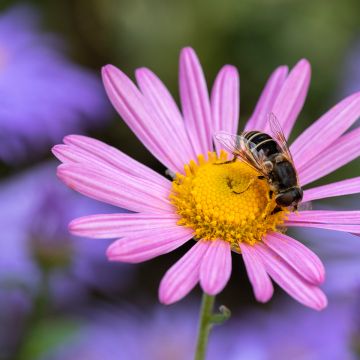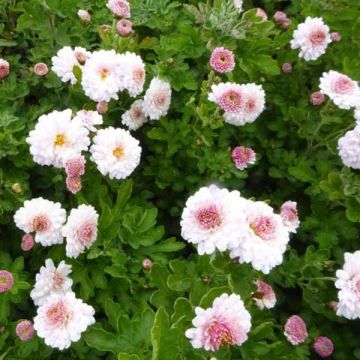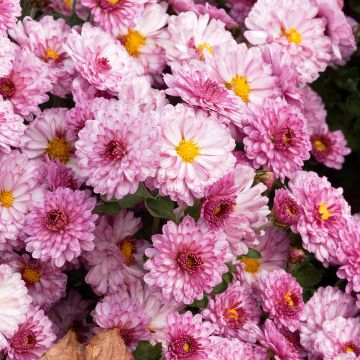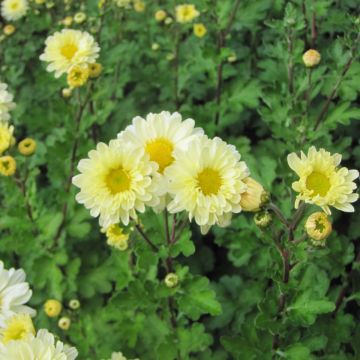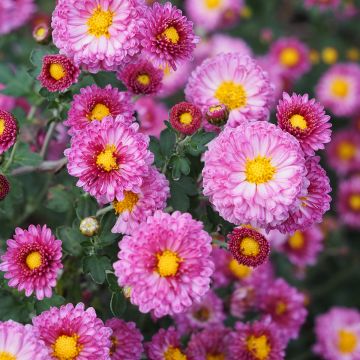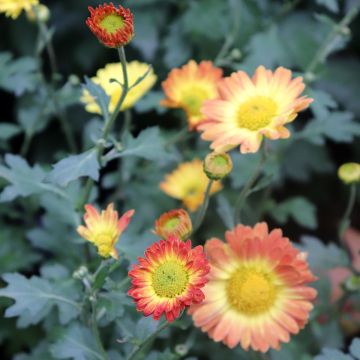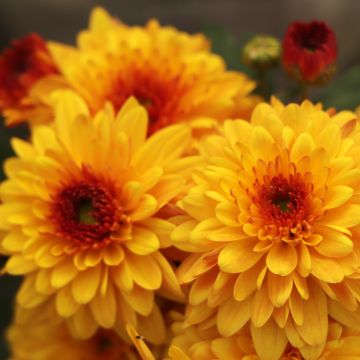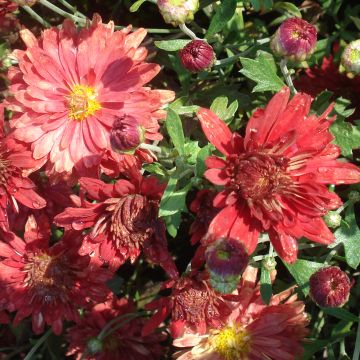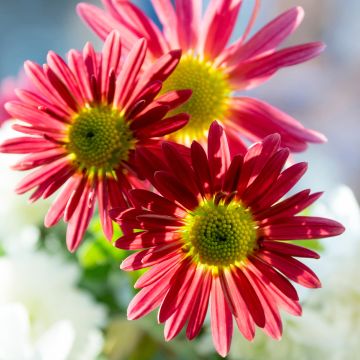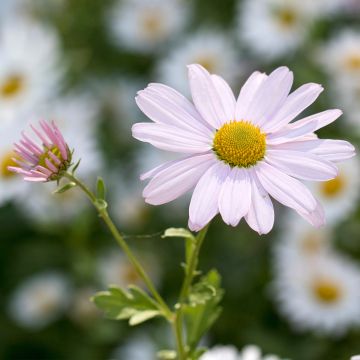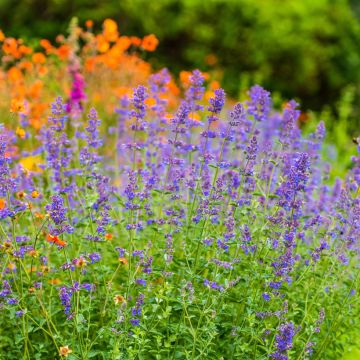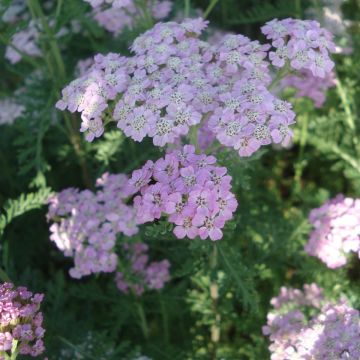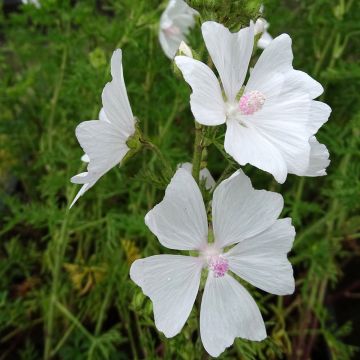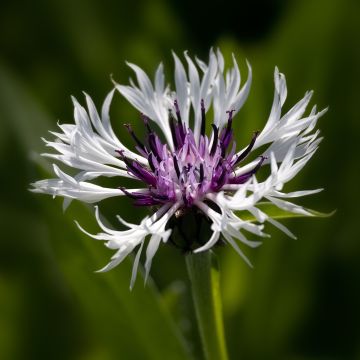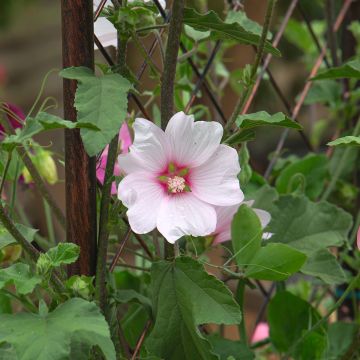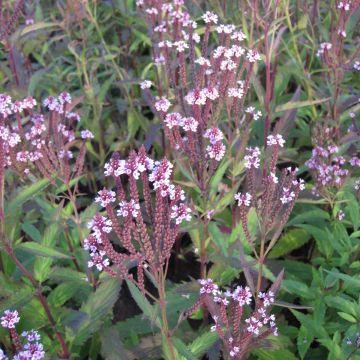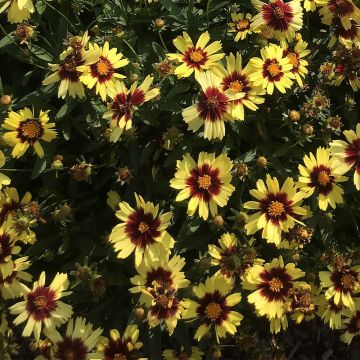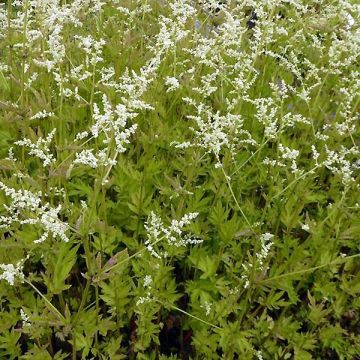

Chrysanthemum indicum Cottage Apricot
Chrysanthemum indicum Cottage Apricot
Chrysanthemum x indicum Cottage Apricot
Garden Mum, Indian Chrysanthemum, Florist's Daisy
This item cannot be shipped to the selected country
Delivery charge from €5.90
More information
Schedule delivery date,
and select date in basket
This plant carries a 12 months recovery warranty
More information
We guarantee the quality of our plants for a full growing cycle, and will replace at our expense any plant that fails to recover under normal climatic and planting conditions.
From €5.90 for pickup delivery and €6.90 for home delivery
Express home delivery from €8.90.
Does this plant fit my garden?
Set up your Plantfit profile →
Description
Chrysanthemum x indicum Cottage Apricot is a particularly robust garden chrysanthemum that blooms in autumn colours. The petals of its flower, initially fine needles, open up wide and flat in a beautiful shade between bronze, caramel, and burnt orange. Then the colour becomes more intense, coppery red. They surround a beautiful acid yellow heart. The heady scent of the flowers evokes honey. This variety is known to bloom for more than 10 years, with great sobriety, as it thrives in even poor and dry soils. Hardy and very perennial, it is perfect in flowerbeds or in pots on a terrace. It quickly forms a beautiful, very flowery clump that lasts several weeks.
The Garden Chrysanthemum is an herbaceous and rhizomatous perennial plant belonging to the Asteraceae family, a cousin of daisies and sunflowers. Cottage Apricot is a cultivar derived from Chrysanthemum indicum, a plant native to East Asia, cultivated since Antiquity in China, Japan, and Korea, which is the origin of florist chrysanthemums. It forms, starting in spring, a bush 70 cm (28in) tall and 50 cm (20in) wide, composed of leafy, branched, woody stems at the base. Its growth is quite rapid. Flowering takes place in September and October. The plant produces numerous flowers grouped in heads, resembling daisies, reaching 7 cm (3in) in diameter, grouped in small bouquets at the top of the leafy stems. The disc is acid yellow, the ligules on the periphery, initially rolled up like needles, unfold wide and rounded. They are a caramel-orange colour, ageing to coppery red. The leaves are triangular-ovate, coarsely divided into 5 lobes and measure up to 5 cm (2in) long. They have toothed edges, a somewhat dull dark green colour, and are hairy underneath. The above-ground vegetation dries up in winter and regrows in spring. Its very perennial stump will live for a long time in the garden.
Garden chrysanthemums offer valuable resources during a slightly less flowery time of year and blend remarkably well with autumn colours. They are often associated with asters, in complementary colours. Their blooming is lightened by that of cosmos, Japanese anemones, gauras, bushy salvias, Magellan fuchsias, Kaffir lilies. They are particularly interesting when paired with grasses: Carex, Stipa, and Pennisetum. Chrysanthemums also make good cut flowers, lasting well in a vase. Consider using taller varieties to create autumn flowerbeds at the base of deciduous shrubs that reflect their yellow, red, and orange autumn foliage.
Report an error about the product description
Chrysanthemum indicum Cottage Apricot in pictures


Flowering
Foliage
Plant habit
Botanical data
Chrysanthemum
x indicum
Cottage Apricot
Asteraceae
Garden Mum, Indian Chrysanthemum, Florist's Daisy
Cultivar or hybrid
Other Chrysanthemum
Planting and care
Garden chrysanthemums require a sunny site in ordinary but well worked soil, slightly acidic, neutral or slightly alkaline, rather fertile, not too dry to moist. They are hardy, to at least -15°C (5°F). To maintain a compact habit, the stems can be shortened in spring, to 30 cm (0 to 12in), this will force the young plant to branch out. A second pinch in the summer allows for a greater number of small flowers. Untamed plants may require staking or circling. Water two or three times a week and provide a liquid fertiliser for flowering plants every eight days from July until the buds become coloured. This plant behaves rather well in partial shade in a warm climate, even in occasionally dry soil, provided it is deep. These plants have few enemies and diseases, except for attacks from gastropods in spring.
Planting period
Intended location
Care
-
, onOrder confirmed
Reply from on Promesse de fleurs
Cottage garden perennials
Haven't found what you were looking for?
Hardiness is the lowest winter temperature a plant can endure without suffering serious damage or even dying. However, hardiness is affected by location (a sheltered area, such as a patio), protection (winter cover) and soil type (hardiness is improved by well-drained soil).

Photo Sharing Terms & Conditions
In order to encourage gardeners to interact and share their experiences, Promesse de fleurs offers various media enabling content to be uploaded onto its Site - in particular via the ‘Photo sharing’ module.
The User agrees to refrain from:
- Posting any content that is illegal, prejudicial, insulting, racist, inciteful to hatred, revisionist, contrary to public decency, that infringes on privacy or on the privacy rights of third parties, in particular the publicity rights of persons and goods, intellectual property rights, or the right to privacy.
- Submitting content on behalf of a third party;
- Impersonate the identity of a third party and/or publish any personal information about a third party;
In general, the User undertakes to refrain from any unethical behaviour.
All Content (in particular text, comments, files, images, photos, videos, creative works, etc.), which may be subject to property or intellectual property rights, image or other private rights, shall remain the property of the User, subject to the limited rights granted by the terms of the licence granted by Promesse de fleurs as stated below. Users are at liberty to publish or not to publish such Content on the Site, notably via the ‘Photo Sharing’ facility, and accept that this Content shall be made public and freely accessible, notably on the Internet.
Users further acknowledge, undertake to have ,and guarantee that they hold all necessary rights and permissions to publish such material on the Site, in particular with regard to the legislation in force pertaining to any privacy, property, intellectual property, image, or contractual rights, or rights of any other nature. By publishing such Content on the Site, Users acknowledge accepting full liability as publishers of the Content within the meaning of the law, and grant Promesse de fleurs, free of charge, an inclusive, worldwide licence for the said Content for the entire duration of its publication, including all reproduction, representation, up/downloading, displaying, performing, transmission, and storage rights.
Users also grant permission for their name to be linked to the Content and accept that this link may not always be made available.
By engaging in posting material, Users consent to their Content becoming automatically accessible on the Internet, in particular on other sites and/or blogs and/or web pages of the Promesse de fleurs site, including in particular social pages and the Promesse de fleurs catalogue.
Users may secure the removal of entrusted content free of charge by issuing a simple request via our contact form.
The flowering period indicated on our website applies to countries and regions located in USDA zone 8 (France, the United Kingdom, Ireland, the Netherlands, etc.)
It will vary according to where you live:
- In zones 9 to 10 (Italy, Spain, Greece, etc.), flowering will occur about 2 to 4 weeks earlier.
- In zones 6 to 7 (Germany, Poland, Slovenia, and lower mountainous regions), flowering will be delayed by 2 to 3 weeks.
- In zone 5 (Central Europe, Scandinavia), blooming will be delayed by 3 to 5 weeks.
In temperate climates, pruning of spring-flowering shrubs (forsythia, spireas, etc.) should be done just after flowering.
Pruning of summer-flowering shrubs (Indian Lilac, Perovskia, etc.) can be done in winter or spring.
In cold regions as well as with frost-sensitive plants, avoid pruning too early when severe frosts may still occur.
The planting period indicated on our website applies to countries and regions located in USDA zone 8 (France, United Kingdom, Ireland, Netherlands).
It will vary according to where you live:
- In Mediterranean zones (Marseille, Madrid, Milan, etc.), autumn and winter are the best planting periods.
- In continental zones (Strasbourg, Munich, Vienna, etc.), delay planting by 2 to 3 weeks in spring and bring it forward by 2 to 4 weeks in autumn.
- In mountainous regions (the Alps, Pyrenees, Carpathians, etc.), it is best to plant in late spring (May-June) or late summer (August-September).
The harvesting period indicated on our website applies to countries and regions in USDA zone 8 (France, England, Ireland, the Netherlands).
In colder areas (Scandinavia, Poland, Austria...) fruit and vegetable harvests are likely to be delayed by 3-4 weeks.
In warmer areas (Italy, Spain, Greece, etc.), harvesting will probably take place earlier, depending on weather conditions.
The sowing periods indicated on our website apply to countries and regions within USDA Zone 8 (France, UK, Ireland, Netherlands).
In colder areas (Scandinavia, Poland, Austria...), delay any outdoor sowing by 3-4 weeks, or sow under glass.
In warmer climes (Italy, Spain, Greece, etc.), bring outdoor sowing forward by a few weeks.

































